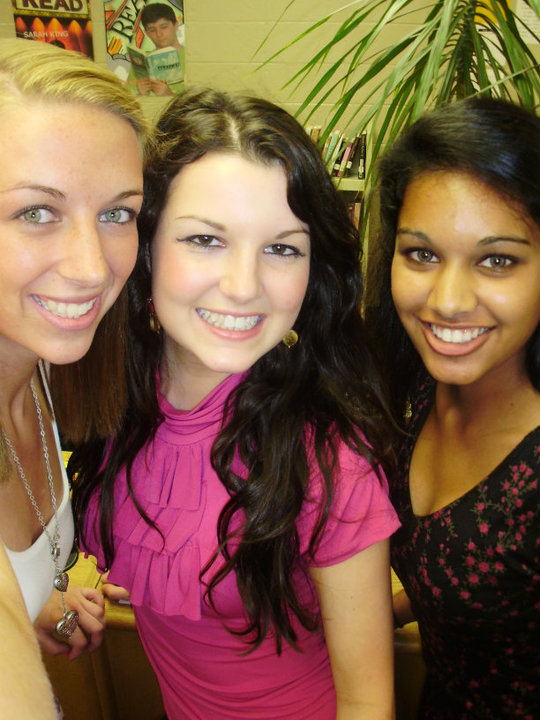Difference between revisions of "User:Arw34"
| (8 intermediate revisions by the same user not shown) | |||
| Line 2: | Line 2: | ||
My name is Angela Woods. My intended major here at Duke is biomedical engineering. | My name is Angela Woods. My intended major here at Duke is biomedical engineering. | ||
| + | |||
| + | [[File:Brooke, Priya, and me.jpg]] | ||
| + | This is a picture with two of my friends from my high school. I'm in the middle. | ||
| + | |||
| + | |||
| + | == Name Pronunciation == | ||
| + | |||
| + | My name is pronounced the way it looks. My first name, Angela, is pronounced "An-guh-luh" (three syllables). My last name (family name) is Woods, pronounced "wUds" (one syllable). | ||
| Line 14: | Line 22: | ||
| − | == | + | == Grand Challenges for Engineering (Links) == |
| + | This following link pertains to the Grand Challenge for Engineering to [http://www.engineeringchallenges.org/cms/8996/9129.aspx Engineer better medicines] | ||
| + | |||
| + | [http://www.ncbi.nlm.nih.gov/pmc/articles/PMC2527668/ Drug delivery and nanoparticles: Applications and hazards], Wim H De Jong and Paul JA Borm, International Journal of Nanomedicine, published online June 2008, accessed 22 September 2010 (Grand Challenge: Engineer better medicines) | ||
| + | |||
| + | |||
| + | == Favorite Demo in MATLAB Help section == | ||
| − | + | My favorite demo in the MATLAB Help section was the Loma Prieta Earthquake (in the Mathematics subsection). It was interesting to see how to apply the mathematical operations in MATLAB to a real-world situation, such as this earthquake. Before viewing the demo, I did not fully understand how plots/graphs worked in MATLAB, so reading this section helped clarify many things for me. I learned the code for various commands, such as changing the line width and specifying the axes. The last part of this demonstration was especially pertinent to my education because, in my Math 103 class, we are currently working with vectors in 3 dimensions. In this MATLAB demo, a trajectory was plotted in three different 2-D graphs (this correlates to parameterization in x, y, and z) and then in a 3-D graph. I liked this demo the most because I could first understand the concept behind the code, and then I learned the code to create computer-generated plots to represent the data. It seems that I will be able to use the information from this demo in many different applications involving plots. | |
Latest revision as of 16:56, 22 September 2010
Contents
About Me:
My name is Angela Woods. My intended major here at Duke is biomedical engineering.
 This is a picture with two of my friends from my high school. I'm in the middle.
This is a picture with two of my friends from my high school. I'm in the middle.
Name Pronunciation
My name is pronounced the way it looks. My first name, Angela, is pronounced "An-guh-luh" (three syllables). My last name (family name) is Woods, pronounced "wUds" (one syllable).
Interests:
Music, Dance, Volleyball, Gym, Health Sciences, People :)
Things to do in life:
Skydive, Wakeboard, Ski, Surf, Climb a Mountain, Travel
Grand Challenges for Engineering (Links)
This following link pertains to the Grand Challenge for Engineering to Engineer better medicines
Drug delivery and nanoparticles: Applications and hazards, Wim H De Jong and Paul JA Borm, International Journal of Nanomedicine, published online June 2008, accessed 22 September 2010 (Grand Challenge: Engineer better medicines)
Favorite Demo in MATLAB Help section
My favorite demo in the MATLAB Help section was the Loma Prieta Earthquake (in the Mathematics subsection). It was interesting to see how to apply the mathematical operations in MATLAB to a real-world situation, such as this earthquake. Before viewing the demo, I did not fully understand how plots/graphs worked in MATLAB, so reading this section helped clarify many things for me. I learned the code for various commands, such as changing the line width and specifying the axes. The last part of this demonstration was especially pertinent to my education because, in my Math 103 class, we are currently working with vectors in 3 dimensions. In this MATLAB demo, a trajectory was plotted in three different 2-D graphs (this correlates to parameterization in x, y, and z) and then in a 3-D graph. I liked this demo the most because I could first understand the concept behind the code, and then I learned the code to create computer-generated plots to represent the data. It seems that I will be able to use the information from this demo in many different applications involving plots.